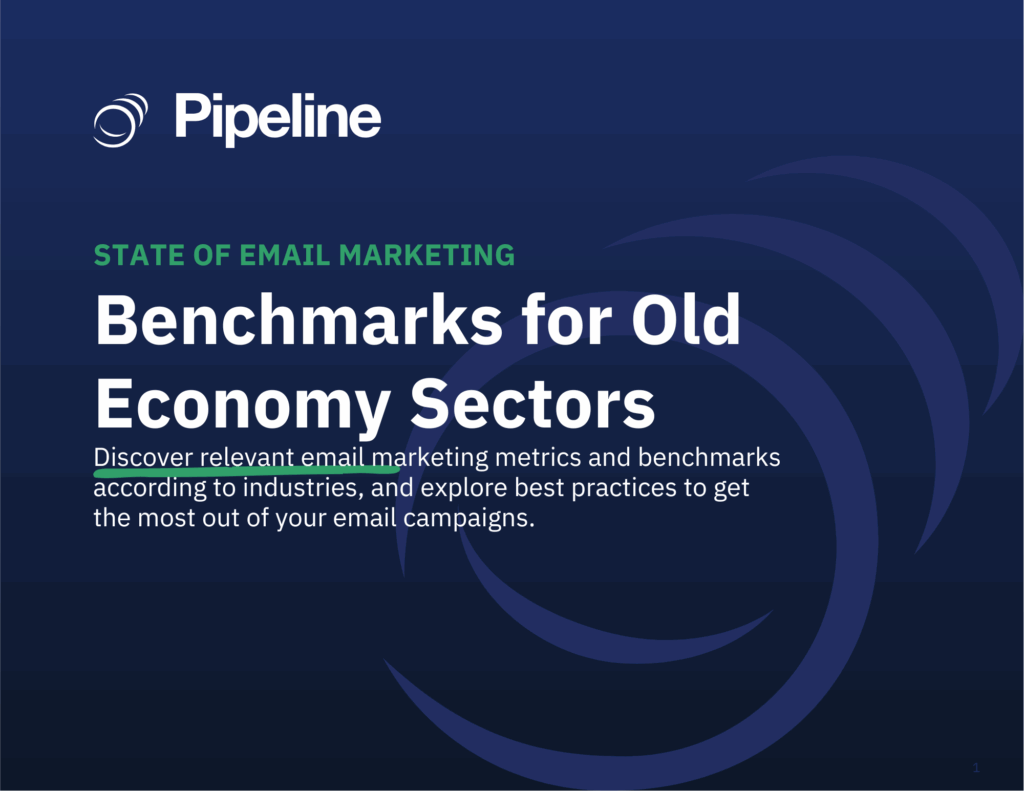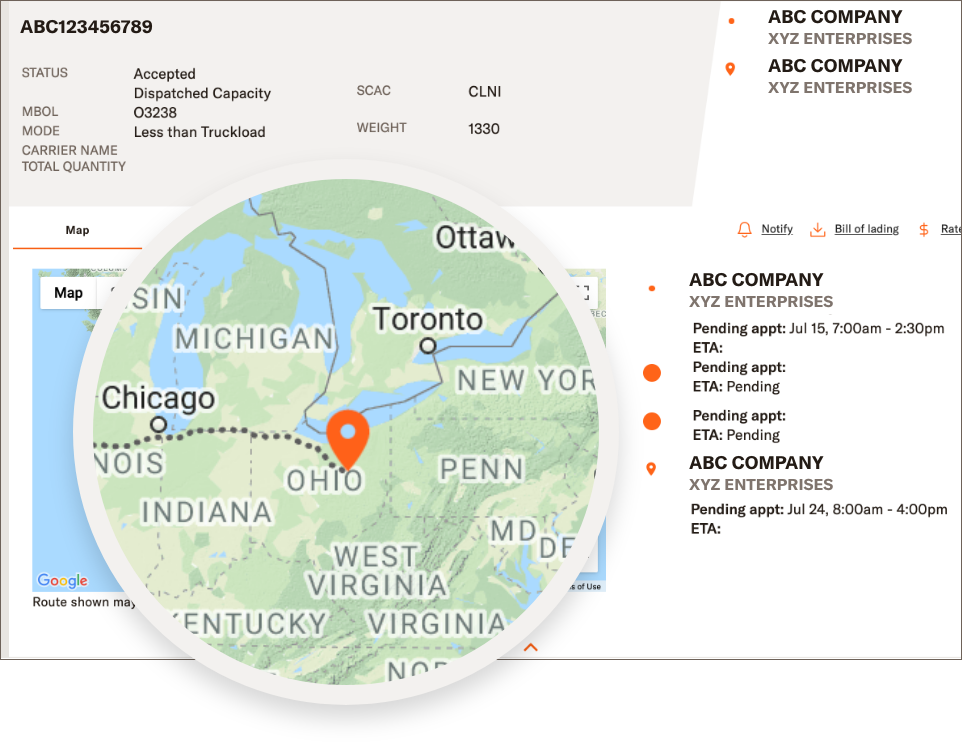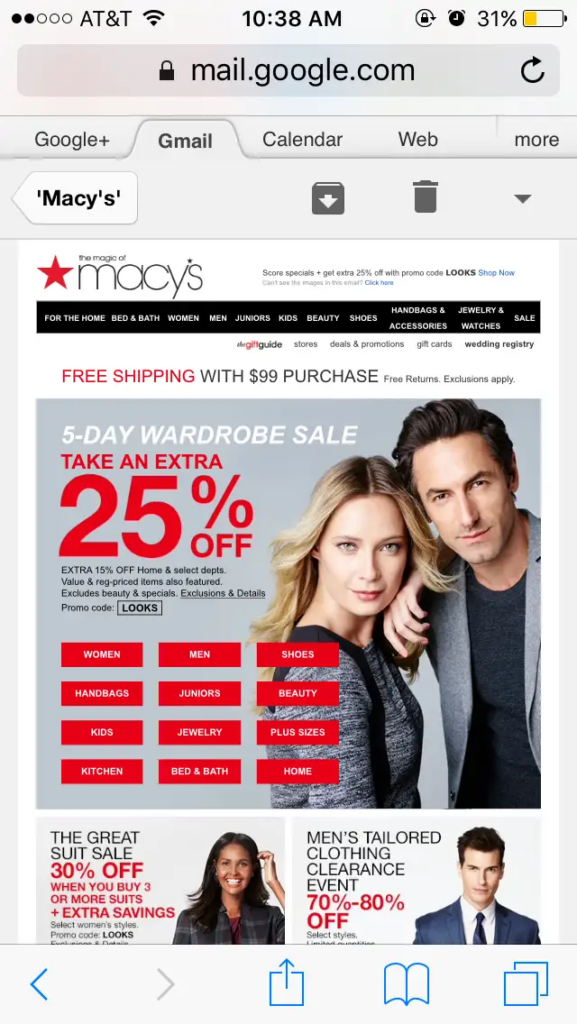How can we increase sales for logistics companies? One way is to create robust email marketing strategies.
In this blog, we’ll delve into four innovative email strategies tailored specifically for logistics and transportation companies. We’ll explore advanced techniques beyond standard practices like personalization and subject lines. Our focus will be on strategies like “email rebound” and “one goal, one link” to maximize impact.
To support these strategies, we’ll also discuss essential tools such as custom CRM for logistics companies and AI-powered email writing assistants.
Before diving into these strategies, let’s establish a solid foundation for logistics email marketing.
Email Marketing Benchmarks for Logistics and Transportation Companies
What is considered a good email marketing benchmark for the logistics and transportation industry?
Based on our research and data from Mailchimp’s study, the email benchmark for the logistics and transportation industry is as follows:
- The average open rate is 33.25%
- The average click-through rate is 2.56%
- The unsubscribe rate is 0.24%
- The hard bounce rate is 0.24%
- The soft bounce rate is 0.78%
Want to know other email benchmarks for manufacturing, construction, and distribution companies? Download our free ebook to get all the details.

Okay, what does this tell us?
Your logistics and transportation customers are still reading your emails, so email marketing is still a viable marketing channel. This fact leads us to the next most obvious question. What’s the best email marketing strategy for logistics and transportation companies?
The Best Email Marketing Strategy for Logistics Companies
The best logistics email marketing strategy builds consistent relationships with customers over time. One vital role of high-performing email marketing is its content.
Generally, there are three approaches to writing good email marketing content:
- Entertainment: Content that’s specifically designed to amuse and delight your audience.
- Education: Systematic, step-by-step instruction that teaches customers how to achieve a specific outcome.
- Edutainment: A combination of educational content and entertainment.
The edutainment approach can work, but getting these customers to spend money is challenging since their primary interest is entertainment. It’s best to choose the right path from the start—in this case, the education. Here’s why.
Customers who seek knowledge are more likely to become loyal customers. By providing valuable insights, such as:
- Case studies
- Customer reviews
- Free courses, apps, and templates
- Quizzes, surveys, and polls
- Webinars and workshops
- Ebooks
- Market updates
You position yourself as a trusted industry expert. These content formats naturally complement each other, creating a cohesive narrative that drives conversions. For instance, market updates can spark interest in case studies, ultimately leading to quote requests and long-term customer relationships.
In the next section, we’ll explore specific email campaign strategies to optimize your educational content.
Strategy 1: Broadcast to AR Sequences
An autoresponder (AR) sequence is an incredibly effective way to segment, qualify, and win customers. You create a list of emails and automatically send them out on a schedule.
If you create compelling email messages, it’s easy to nurture, follow up with, and close new customers. However, if the emails are filled with meaningless content, your prospects will remove themselves from the conversation.
How do you consistently attract customers and boost revenue with AR sequences?
The answer lies in rigorous message testing. By sending out broadcast emails, your sales team can experiment with different content types and messaging to identify what truly resonates with your audience. Broadcast emails offer a low-risk environment to test various elements such as:
- Timing and frequency
- Subject lines, sender names, wording, and calls-to-action
- Visuals
- Landing pages
- Personalization and offers
- Customer segmentation
Once you’ve pinpointed the winning combinations, integrate these high-performing messages into your AR sequences. This strategic approach maximizes your return on investment by ensuring your automated communications deliver consistent results.
Using Email Broadcasts with Pipeline CRM for Logistics
To successfully implement this strategy, you’ll need:
- A diverse range of content tailored to different customer segments.
- Sales reps actively share content and provide feedback within your CRM.
- Detailed performance metrics to identify top-performing content.
- A well-structured content tagging system.
And follow this process:
- Create and Test Broadcast Emails: Develop a variety of broadcast messages aligned with your content library. Conduct statistically significant tests by sending emails at different times, ensuring equal sample sizes for each test group. Utilize BCC tracking within your CRM, like with Pipeline CRM, to gather comprehensive performance data.
- Identify Winning Messages: Analyze test results to determine the most effective content, timing, and messaging.
- Integrate into AR Sequences: Incorporate high-performing broadcast messages into your automated response sequences to optimize customer engagement and conversions.
By following these steps and leveraging the necessary resources, you can significantly enhance your email marketing efforts and drive revenue growth.
Need AI help to streamline your email marketing messages?
Check out Pipeline CRM’s built-in AI email writing feature. It empowers you to write and re-write a personalized email with just a few clicks. See the demo below and learn more about its extensive use in this AI email writing blog.

Broadcast Email Templates to Re-Engage Cold Logistics
| Hi [First name],
It’s been a while, and I’d love to touch base again.
Just wanted to see if you need our services again. Here are some of our quick wins that might be of interest to you:
Brands like [Brand 1] and [Brand 2] are already seeing improved delivery rates and lower overheads. In fact, one of our clients, [Brand 3], has seen [X%] faster delivery times and significant cost savings by optimizing just one part of their supply chain with us.
If logistics is back on your priority list, let’s reconnect.
You could either book a quick call (hyperlink) or reply to this email.
Regards, [Signature] |
Strategy 2: Email Sales Phases
What’s the fastest way to build trust with prospects? You set expectations and then meet them. Successful email campaigns operate in phases, each with a specific goal or objective. Every email you send should fit into one of these five phases.
- Indoctrination: You introduce prospects to your company, set expectations, and make friends.
- Engagement: You chat with prospects about their desires, goals, and interests. After you introduce them to a relevant product and service, you ask for the sale.
- Ascension: You welcome new customers, and you invite them to purchase a relevant product or service from you again.
- Segmentation: In this phase, you determine what customers want to learn from you and what they want to buy next.
- Re-engagement: This phase is all about reigning a warm relationship that has gone cold—restoring the relationship.
Sales is the natural byproduct of relationships. These goals keep your team’s focus on building strong relationships. Additionally, your prospects expect you to provide value in every interaction. This means every email you send should have compelling value for customers.
Using Email Phases with Pipeline CRM for Logistics
Work to create one to two messages for each phase.
- Indoctrination messages (e.g., welcome, expectations, or cadence messages) should answer the who, what, why, how often, and next steps questions.
- Engagement messages are focused on one thing: closing. The purpose of engagement emails is to make an offer. This is essential for logistics companies because customers often treat your industry as a commodity. An irresistible offer changes that—it’s simply too good for customers to pass up. For logistics, this could be as simple as sharing their quotes and letting them know when their quote is about to expire.

- Ascension messages are intended for customers who purchased in the engagement phase. For every customer who made a purchase, there are still more customers who would buy more. For example, customers who purchased 3PL services may be interested in warehousing services.
- Segmentation messages are designed to get customers (or prospects) to raise their hands and express interest in a specific topic or service. Once that happens, prospects are placed in the engagement series relevant to their interest.
- Re-engagement messages help your logistics company to restore the relationship, re-engage, win back, and re-energize old or dying leads.
Logistics Sales Email Templates for Proposal and Decision-Stage Follow-Ups
When you have sent a proposal and are waiting for the client’s decision, following up can be tricky. You don’t want to look too pushy, nor do you want the lead to go cold. So what’s the right balance?
Here is a logistics email template to help you follow up and keep the deal moving without sounding intrusive.
| Hi [First name],
I’m checking in to see if you have had a chance to review our proposal from our last discussion for [Project/Service] from [Date]. I understand you are likely busy, so we just wanted to make sure it’s not lost in the mix.
Here’s a quick summary of the proposal we sent you:
If you have any questions or require further clarification, let’s schedule a quick call to discuss any concerns.
Best regards, [Signature] |
Sending individual follow-up emails to each client manually takes a lot of time that you could be using to improve sales strategies.
So what’s the solution? Automate your follow-up emails with Pipeline CRM.
You can segment your email list according to demographics and deal stages, and set up advanced rules and conditions to choose who gets your emails. You can even run A/B tests so your follow-ups are highly relevant and help you close deals a lot faster.
Strategy 3: Boost Conversions with ‘One Goal, One Link’ Technique (1G1L)
Let’s take a look at an example in an unrelated industry. It’s common for email marketing newsletters to look like this:

Macy’s email marketing often falls victim to overcomplication. Overloaded with multiple links (31 to be exact) and unclear objectives, these emails fail to resonate with specific customer segments.
To enhance email effectiveness, adopt a 1G1L strategy: One Goal, One Link. By focusing on a single, clear objective and directing customers to a specific action, you significantly improve the chances of conversion.
The power of clarity cannot be overstated. When customers can quickly grasp your offer, they are more likely to engage and convert. This principle aligns with the core components of a strong value proposition: clarity, appeal, exclusivity, and credibility. A clear message is the foundation upon which these elements can be built.
By simplifying your email content and directing attention to a single call to action, you enhance cognitive fluency and increase the likelihood of customer action.
Using 1G1L with Pipeline CRM for Logistics
A robust CRM is essential for executing a successful 1G1L strategy. Unlike email service providers, CRMs offer a comprehensive view of customer interactions, enabling granular data analysis.
This rich data empowers you to:
- Create highly targeted segments: Identify specific customer groups based on behavior and preferences.
- Develop laser-focused offers: Tailor content and calls to action for maximum impact.
- Measure campaign performance accurately: Pinpoint the effectiveness of each email and optimize future efforts.
By simplifying your email messaging and combining it with robust CRM data, you eliminate the guesswork often associated with complex marketing campaigns. This approach fosters accountability and empowers your team to make data-driven decisions.
High-Converting Quote Request Email Templates for Logistics Businesses
Now, when the lead you worked so hard to nurture finally asks for a quote, your reply has to sustain the warmth and interest you have built over the stages. So, just sending them some vague estimation won’t work. Your job is to make it easy for them to say yes.
Add this template to your email marketing campaigns to guarantee a positive response:
| Subject: Your logistics quote is ready
Hi [First Name],
Thank you for reaching out to us and showing interest in our services. We would be delighted to help with your logistics needs.
Based on the details you shared, here is a quick overview of your quote:
This quote includes real-time tracking, dedicated support, and flexible scheduling.
If you have additional details about your requirement or need a more customized solution, please reply to this email or reach out to us at [abc@company.com]
Best regards, |
Strategy 4: Rebound To Build Relationships

Email metrics offer valuable insights, but they provide a limited view of customer engagement. Traditional metrics like open rates, click-through rates, and conversion rates paint a partial picture. To gain a deeper understanding of customer behavior and optimize marketing efforts, a more holistic approach, like rebounding, is required.
Rebounding is the key to unlocking a wealth of data. By guiding prospects from email to website, social media, and beyond, you create a comprehensive customer journey. This interconnected approach allows you to:
- Measure engagement at every touchpoint: Track interactions, preferences, and buying signals across different platforms.
- Build stronger customer relationships: Foster deeper connections through personalized and relevant content.
- Optimize marketing spend: Allocate resources effectively by identifying high-performing channels and campaigns.
Consider this example: A prospect engages with an email case study, visits the website, shares content on social media, and ultimately becomes a customer. This journey generates a wealth of data that can be analyzed to refine future marketing strategies.
By embracing a rebounding approach, businesses can transform data into actionable insights, driving increased customer acquisition and retention.
Using Rebounding with Pipeline CRM for Logistics
“How to increase sales for logistics companies.”
It’s a common question logistics companies ask Google. Rebounding via CRM retargeting is a straightforward way for logistics companies to increase sales. You take your first-party data—specific lead segments or your email list as a whole—and connect it to your customers on other platforms (e.g., Google Ads, LinkedIn Ads, etc.).
With CRM retargeting, the sky’s the limit. You can use it to:
- Sort subscribers into segments (groups based on attributes) or cohorts (groups based on behavior) and sell to those groups specifically on third-party platforms.
- Precisely target offers—upselling, downselling, or cross-selling to ultra-relevant groups.
- Presell exclusive offers or incentives to specific segments or cohorts (e.g., medium-sized ecommerce retailers who need warehousing support) via your marketing channels (e.g., email, social, paid ads, organic search, etc.).
- Create content that’s tailor-made for specific segments or cohorts.
Here’s the best part about CRM retargeting. It’s a cookie-less, more precise, and privacy-friendly option that allows logistics and transportation companies to work with prospects who are already on their list.
It’s also important to give each marketing channel and platform its own content. It’s common for people to take the easy way out: They create content once and then share the same content on all their social media profiles. You’re training your subscribers and customers to ignore your content.
If they follow you on Facebook, they won’t follow you on Instagram or LinkedIn because you share the same content everywhere. They don’t want to see the same content in their inbox repeatedly.
This frustration doesn’t mean you can’t discuss the same topic. You absolutely can just change the angle.
Let’s say you decided to share a 3PL whitepaper on LinkedIn. You can also:
- Share a PDF presentation on SlideShare
- Post images of cargo theft on Instagram
- Upload a “How to find a great 3PL” YouTube
- Research factoid from your whitepaper on X
The topic is the same, but the content varies depending on the channel and platform. This approach gives subscribers/followers a compelling reason to follow you across all marketing channels.
Check-In Email Templates to Rebuild Logistics Client Relationships
Here is a check-in template to help you out:
| Subject Line: A quick update from our team
Hi [First Name],
I wanted to check in and see how things are going at your end. In case you have had any issues with our services that made you reconsider, please let mr know. I would love to resolve any issues.
I would also like to share a few updates:
If you are open to a quick chat, I would love to hear how things are going on your side, too.
Let me know what works best.
[Signature] |
Strategy 5: Geo-Targeted Email Campaigns to Personalize Logistics Outreach
If you are reaching out to customers or businesses in different regions, sending the same email to everyone just doesn’t work. Shipping challenges in Chicago won’t be the same as those in Nebraska, and your emails must reflect that to convince the prospect.
That’s why you should optimize your email campaigns with geo-targeting so that customers only get emails relevant to their specific region and its logistics challenges.
Follow these steps to run highly targeted email marketing campaigns:
- Segment your customer list by location and send updates on new service lanes, route expansions, or local partnerships
- Highlight region-specific case studies to build trust and credibility
- Offer time-bound discounts or perks tailored to high-demand delivery zones
- Send regional alerts for delivery disruptions or delays
- Promote local warehousing or fulfillment solutions to businesses in high-density areas
- Share localized insights or reports on shipping trends, fuel costs, or route efficiencies in their area
Using Lead Segmentation and Location-Based Customization with Pipeline CRM
Let’s say you’re sending logistics emails to prospects in Miami. Here is how it could look:
| Subject: Faster and Reliable Logistics Solutions Now Available in Miami!
Hi [First name],
Are you shipping in or out of Miami? We know how critical timely deliveries are!
That’s why we are excited to offer exclusive logistics solutions tailored for Miami businesses, including:
Limited-time offer: Sign up and get 10% off your first shipment.
Interested in learning more and getting a custom quote? Reply to this email or give us a call at [abc@company.com]!
Regards, |
But the problem is, you won’t do this for one location. That means multiple customer segments with overlapping elements.
How do you make sense of all this? Leverage Pipeline CRM’s lead management, and let us help you with:
- Organizing leads by region, demographics, and more
- Tracking every interaction with detailed records
- Using historical data and profiles for context
- Sending emails that feel personal and value-driven, drafted using our AI email assistant
Email Marketing Is the Future of Logistics
Contrary to popular opinion, email marketing for logistics and transportation companies is growing. And if you haven’t optimized your email marketing strategies, it’s time to level it up.
The best email marketing strategy builds consistent relationships with customers over time. Focus on content that leads to revenue. Orient your team around the primary goal—more revenue—and you’ll find identifying the right email marketing strategy is simple.
If you’re looking for a CRM that supports seamless integration with Gmail, Outlook, and email marketing apps like Mailchimp, Pipeline CRM is a great option. Plus, we offer a built-in email drip campaign and AI email writing assistance features, empowering you to do more to increase your logistics email marketing performance and, ultimately, the sales funnel.
Check out Pipeline CRM’s email solutions; and when you’re ready to try it for free, sign up here.



